Jewels of Medieval Miniature
|
Jewels of Medieval Miniature
From 18 to 28 Septembre 2008
Sala Oberta - La Nau
Opening hours: From Monday to Saturday From 10 h to 20 h.
Sunday: From 10 to 14 h
|
|
|
|
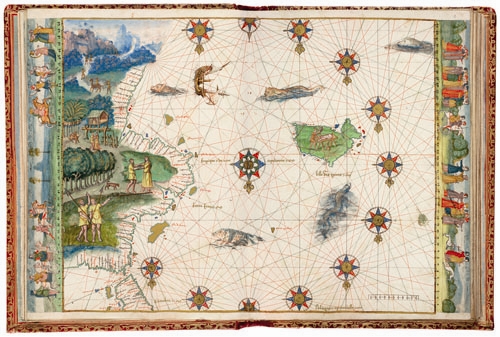
|
|
Atlas Vallard,
1547
Original at The Huntington Library, San Marino
(California).
68 pages; bound in red, gold-stamped leather.
Possibly produced in Dieppe (France) by a Portuguese
cartographer or based on a Portuguese prototype, this
world atlas includes 15 richly illustrated nautical
charts as well as nautical information, declination
tables, etc. Its first known owner was Nicolas Vallard,
from Dieppe.
Apart from clearly Portuguese geographical drawings and
contents, the atlas shows the print of a professional
illuminator, either French or Flemish, who painted
extraordinary images comparable to those of the Miller
Atlas.
This anonymous atlas includes a series of beautiful
scenes depicting extra-European exotic populations,
colonisation episodes, etc. An example of these scenes
is that of the French settlers in Roberval in 1542-1543,
after the discovery of Canada by Jacques Cartier in
1534-1536 and 1541. |
|
|
|
M. MOLEIRO EDITOR PUBLISHING WORKS
M. Moleiro Editor is the most prestigious publishing
house specialised in the reproduction of codices, maps
and unique illuminated manuscripts, true jewels made
between the 8th and the 16th
century.
The codices are not only singular for their beautiful
illustrations but also for their historical and
scientific importance. The works selected make up a
testimony of past times in which precious and exclusive
objects had another dimension. Financed by emperors and
kings, their production was commissioned to the most
prestigious artists of the time, who left their artistic
print between the pages. Combined with the wisdom and
craft of the trade, the techniques used in the works of
M. Moleiro Editor result in loyal reproductions of the
original, taking care of every little detail. Bound in
leather tanned with old methods and printed on special
hand-made paper, with the same touch, thickness and
smell as the original parchment, the codices reproduce
all the nuances of the paintings, the parchment, the
gold and silver... We could actually state that a M.
Moleiro Editor codex is almost an original. In fact,
these editions are like new originals that can hardly be
told apart from those that were once in the hands of
monarchs and emperors. The editions are unique and
unrepeatable. They are strictly limited to 987 duly
numbered and authenticated copies, each of them having a
notary deed to prove their exclusivity. To understand
and appreciate the works as a whole, each quasi-original
comes with a study volume written by international
specialists including a collection of essays about the
most relevant aspects. |
|
THE EXHIBITION
The exhibition “Jewels of Medieval Miniature” will be
opened until 28th September at the Sala
Oberta of the Cultural Centre La Nau, of Valencia
University. More than 30 “quasi-originals” are
presented. Preserved at the most important museums of
the world (Bibliothèque Nationale de France, Biblioteca
Nacional, British Library, Biblioteca Casanetense,
Biblioteca Nazionale Marciana, National Library of
Russia, Pierpont Morgan Library, etc.), they are loyal
reproductions of codices that survived the passing of
time. Among the exhibits are the following titles, on
different subjects: |
|
|
|
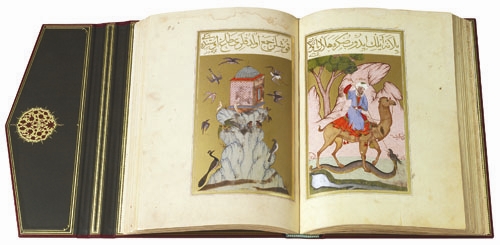
|
|
Le Livre du Bonheur, c. 1582.
Original at the Bibliothèque Nationale de France, Paris.
Commissioned by the sultan and caliph Murad III (his
portrait can be seen in f. 8v), this luxurious codex is
a compilation of different treaties of a scientific and
astrological nature: predictions for those born under
the twelve horoscope signs illustrated with splendid
miniatures, predictions for different situations of
human beings based on planetary conjunctions, tables of
physiognomic concordance, tables to interpret dreams,
and a vast fortune telling chapter. The oriental world
unfolds in front of us in each miniature: mysterious
characters in a strange pose, colourful exotic garments,
luxurious mansions and sumptuous palaces, the Tiberiades
baths, the Maidens Church, the Omayyad mosque in
Damascus… |
|
|
|
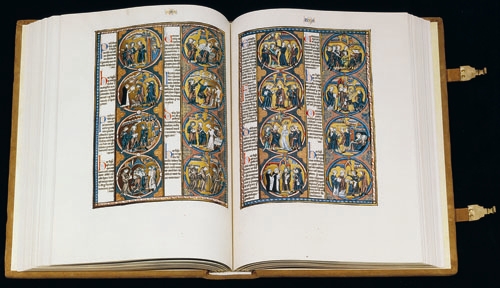
|
|
St. Louis Bible
Original at the Cathedral of Toledo.
3 volumes, 1,230 pages. The most important
bibliographical treasure of Christianity.Produced
between 1226 and 1234 in Paris for the education of King
Saint Louis following a commission by his mother, Blanca
of Castile. 4,887 illuminated medallions with biblical
scenes. A highly valuable jewel considered by Alfonso
X el Sabio to be suitable for monarchs only. |
|
|
|
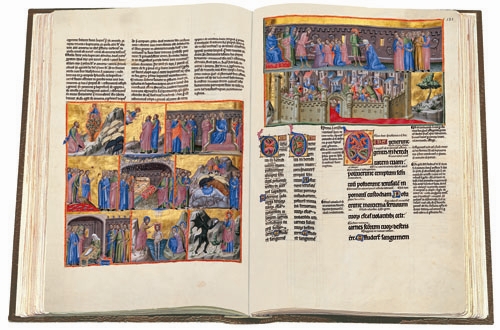
|
|
Glossed Psalter,
13th / 14th centuries.
Original at the Bibliothèque nationale de France, Paris.
Arranged in three columns, the text includes psalm
versions in Hebrew, Roman and Gallican. The manuscript
was illustrated in two different periods: Canterbury, c.
1200, Catalonia, c. 1340, by the master Ferrer Bassa.
With 356 pages and more than 140 fascinating miniatures
decorated in gold. |
|
|
|
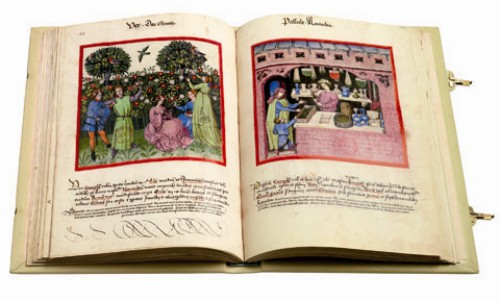
|
|
Tacuinum Sanitatis
Original at the Bibliothèque nationale de France, Paris.
In the late Middle Ages, the princes and the powerful
learned the rules of health and hygiene of rational
medicine in the Tacuinum Sanitatis, a treaty on
well-being and health, widespread in the 14th
and 15th centuries.
It was originally written by Ububchasym de Baldach, also
known as Ibn Butlân, a Christian physician born in
Baghdad who died in 1068. He suggests six elements to
stay healthy: food and drink, air and ambience, movement
and rest, sleep and wakefulness, humour secretion and
excretion, and mood motion or affect (happiness, range,
shame…). According to Ibn Butlân, disease appears when
the balance of some of these elements is disrupted, for
which reason he advises to lead a life in peace with
nature, to be able to preserve and restore health. |
|
|
|
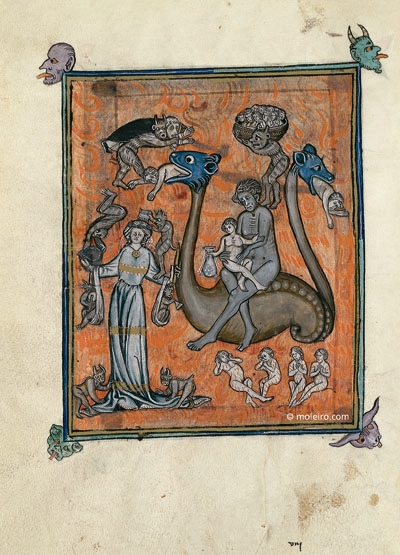
|
|
Apocalypse 1313
Original at the Bibliothèque nationale de France, Paris.
Signed and dated in 1313 by its illuminator, Colin
Chadewe, this piece is unique, for it seems to have been
designed to satisfy the highest standards. The
manuscript includes an exceptional set of images both
for their abundance and the quality of the painting
technique. This codex covers the largest iconographical
cycle of the Book of the Apocalypse of the Middle Ages. |
|
|
|
OPENING SPEECH
On the occasion of the exhibition opening, a lecture
entitled "The illumination art of miniated codices” will
be given by Felipe Vicente Garín Llompart (PhD) on
September 18th at 19 h. The speaker is an art
history professor at the Polytechnic University of
Valencia and and Honorary Director at the Prado Museum.
|
|
|
|
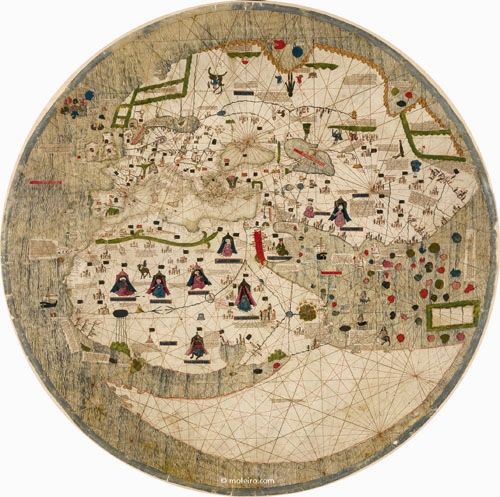
Mapamundi Catalán |
|
|
|

Atlas Miller planisferio |
|
|
|
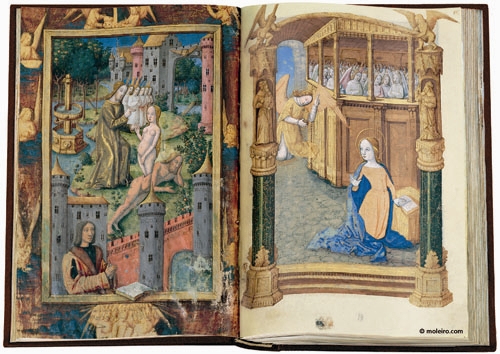
Libro Horas Luis de Orleans |
|
|
|
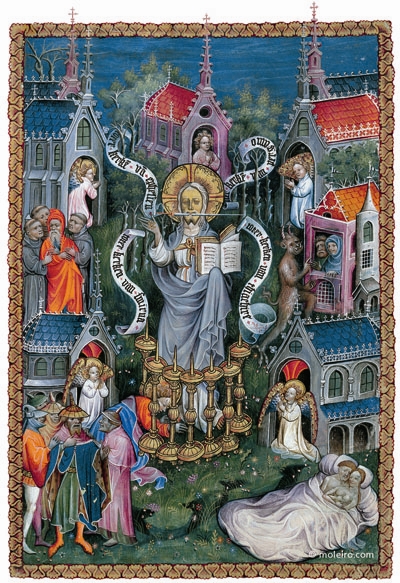
Apocalipsis Flamenco |
|
|
|
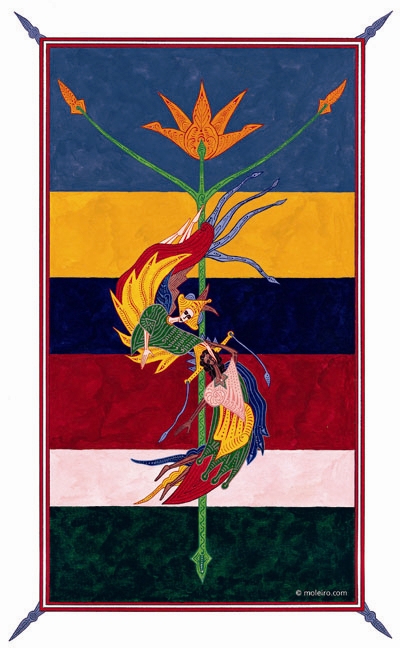
Cantar de cantares |
|
|
|
|